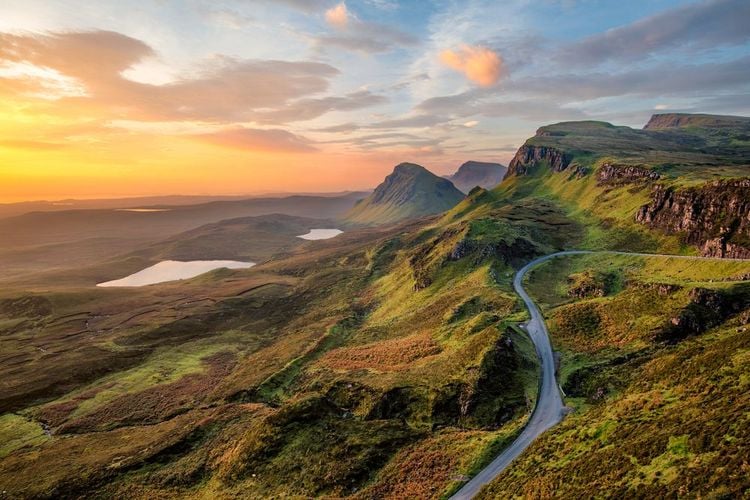The site where we find Glasgow today has been settled since prehistoric times. The area became a Roman stronghold and is also the site where the Antonine Wall was built in 142 CE, roughly 20 years after Hadrian’s Wall was finished, in order to keep Celtish and Pictish Caledonia separate from Roman Britannia. Many Roman artefacts from the time period have been found around Glasgow as a result of various archaeological digs and excavations and can be found at the Hunterian Museum. After the Romans withdrew from the Glasgow area, still a village at the time, it became part of the Kingdom of Strathclyde until the 9th century when it merged with other regions to form the Kingdom of Scotland. Glasgow gained importance through its bishopric in the 10th and 11th centuries and became a city by today’s standards. Glasgow Cathedral was then consecrated in 1197 and the University of Glasgow was founded by papal bull in 1451, establishing the city as an important hub both religiously and academically and making the university the fourth-oldest in the English-speaking world.
Bursting with culture and history, Scotland’s largest city is strikingly sophisticated and unpretentious. One of the most spectacular cities in Europe, Glasgow is brimming with cool, radiating with life and abounding in rich architectural legacies. Locals are witty, welcoming and down-to-earth and breathe warmth into any bitterly cold Scottish day. The Victorian city centre is well loved by artists globally, particularly filmmakers as it is said to resemble 19th century New York, although Glasgow’s charm is undeniably its own.
Every way you look, you’ll find something of note, even in the narrowest streets and the shadowiest corners. Glasgow is full of impressive history that helped shape the world we live in today, and is particularly proud of its strong working-class background. No trip to Scotland would be complete without spending some time in this astonishing and irresistible city and making the most of all the wonderful things it has to offer.
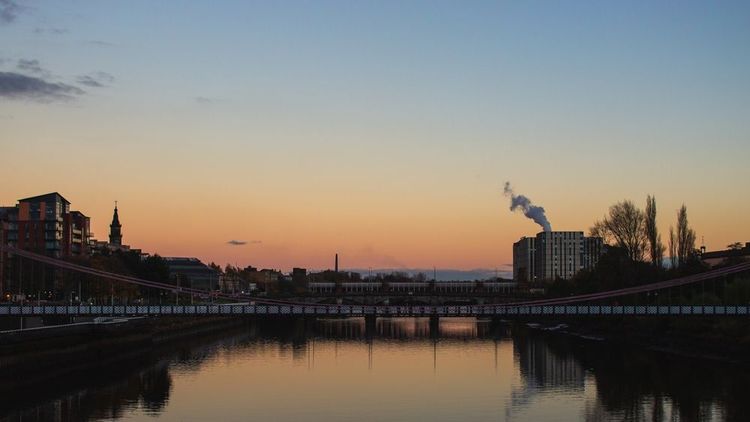
Glasgow sunset at the Portland Street suspension bridge over the River Clyde
- © nathanchung / ShutterstockGlasgow’s history
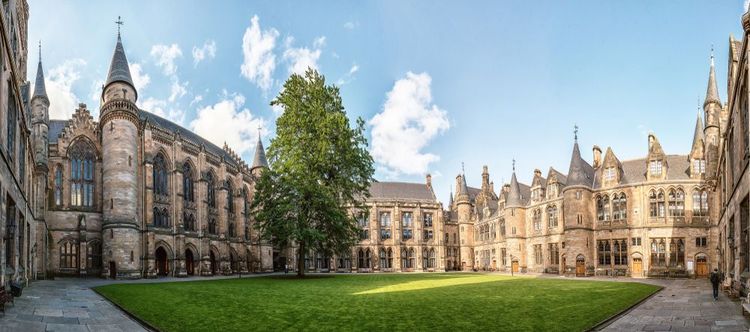
University of Glasgow, Scotland, UK
- © Martin Gaal / ShutterstockGlasgow’s history is also key to understanding the history of politics in Great Britain. During the Industrial Revolution, Glasgow became an important shipping and merchant city. Shipbuilding on Clydeside rapidly became an industry benchmark of quality. The First World War brought many more shipbuilding contracts and a large majority of Glaswegians were put to work in Clydeside. The post-war era brought on the emergence of an extremely significant political movement, “Red Clydeside”, led by militant trade unionists, which would go on to define the Labour movement throughout Britain in the years to come.
The Shop Stewards Movement originated in Clydeside in 1917 and arose from the many strikes being organised at the time in the area. One of the movement’s leading figures, Willie Gallacher, ultimately went on to win a seat in West Fife in the 1935 general election and became the only MP of the Communist Party of the United Kingdom to sit in the House of Commons.
Exploring Glasgow’s galleries and museums
Glasgow majorly delivers on the museum front. It’s a culture lover’s dream, whether you want to see some paintings, brush up on some world history or familiarise yourself with local archeological endeavours.
Riverside Museum offers an excellent display of Glasgow’s historic transport and technological prowess. Having played a central role in the Industrial Revolution, this museum gives an incredible insight into the city’s contributions to shipbuilding, train manufacturing and engineering. Located on the Clyde waterfront, the building housing the museum is an incredible structure designed by architect Dame Zaha Hadid. The museum is open Monday through Thursday and Saturday from 10am until 5pm and Friday and Sunday from 11am until 5pm. Admission is free.
The Gallery of Modern Art or GoMA features an incredible collection of modern art and some fantastic seasonal exhibitions. The Gallery is located in the very centre of the city, the neo-classical building is stunning and the iconic statue of the Duke of Wellington is right outside it so you can’t miss it. The museum is open Monday through Thursday and Saturday from 10am until 5pm and Friday and Sunday from 11am until 5pm. Admission is free.
The Hunterian is an unmissable staple if you’re interested in ancient civilizations and archaeology. As part of the University of Glasgow, the museum features some fascinating academic research and some of the most recent scientific and historical discoveries in the Glasgow area. The museum is open from Tuesday to Sunday from 10am until 5pm. Admission is free.
Kelvingrove Art Gallery and Museum is housed in a stunning building that has been a staple of Glaswegian cultural life since 1901. Made up of 22 incredible galleries that feature a wonderfully varied collection of artefacts, Kelvingrove is an unmissable part of any trip to Glasgow. The Gallery is open Monday through Thursday and Saturday from 10am until 5pm and Friday and Sunday from 11am until 5pm. Admission is free.
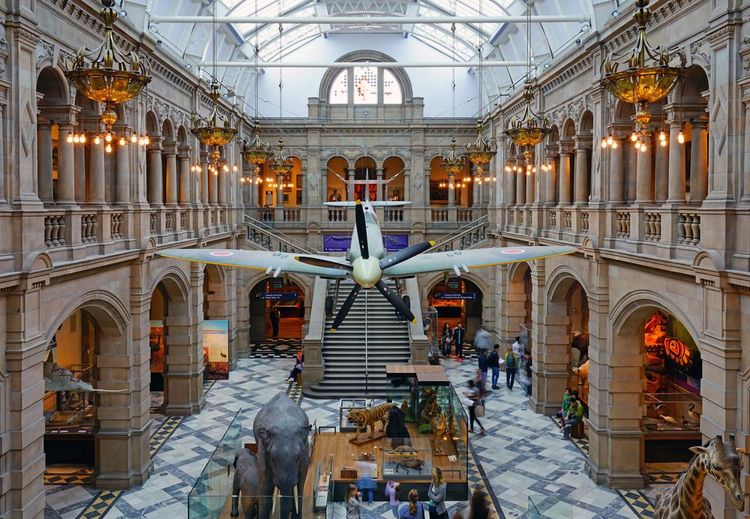
Interior of the Kelvingrove Art Gallery and Museum with a Spitfire plane hanging over the main gallery.
- © EQRoy / ShutterstockSee the sights
Glasgow is full of awe-inspiring monuments, buildings and various sights to see. Here are some of our favourite ones that we think are essential to any successful trip to Glasgow.
The Glasgow Necropolis
Established in 1832, this Victorian cemetery was built on a hill overlooking the city, to the east of Glasgow cathedral. The Glasgow Necropolis was modelled after the Père Lachaise Cemetery in Paris and features around 3,500 tombs. It’s worth walking around and enjoying the Classical Revival-style architecture of all the monuments and the spectacular view of the city. The Friends of the Glasgow Necropolis also organise some fascinating guided walking tours of the 37 acre cemetery which will provide visitors with some insights into the stories of the people buried here.
The cemetery is open every day of the year and opening times vary so be sure to check them close to the date you plan on visiting.
Glasgow Cathedral
Glasgow’s majestic gothic cathedral is the oldest cathedral in mainland Scotland, and the oldest building in Glasgow. Consecrated in 1197, the cathedral was dedicated to Saint Kentigern, known more widely as Saint Mungo, Glasgow’s patron saint whose tomb lies at the heart of the building’s Lower Church. Throughout the centuries, Glasgow Cathedral weathered many historic transformations but today, the congregation is part of the Church of Scotland’s Presbytery of Glasgow.
The cathedral is located within walking distance from the city centre and can be found next to the Royal Infirmary. It is open from April 1 to September 30: Monday to Saturday from 10am to 5pm and Sunday from 1pm to 5pm and then from October 1 to March 31: Monday to Saturday from 10am to 4pm and Sunday from 1pm to 5 pm. The cathedral is closed for lunch from 12 noon to 1pm. Admission is free.
Botanic Gardens
Located in the heart of the city’s West End, by the River Kelvin, the Botanic Gardens are a beautiful and energising place to visit. It contains a lush and exotic plant collection, many riverside walks and of cours, the iconic Kibble Palace. The Palace is a stunning glasshouse designed by John Kibble and is home to the national collection of tree ferns. Visitors can also tour the Palm House in which tropical rainforest plants grow.
The Gardens are open from 7am until dusk all year, with the glasshouses open from 10am until 6pm (4pm in the winter). Admission to all areas of the Gardens and glasshouses are free.
University of Glasgow
The 550 year old University of Glasgow has an incredible campus that displays some of the city’s most commanding architecture. Spread across the city, it is worth taking the time to visit the various campus buildings and taking in the institution’s grandiose history. Guided tours are also available and free to attend, they take place Tuesdays through Sundays at 2pm.
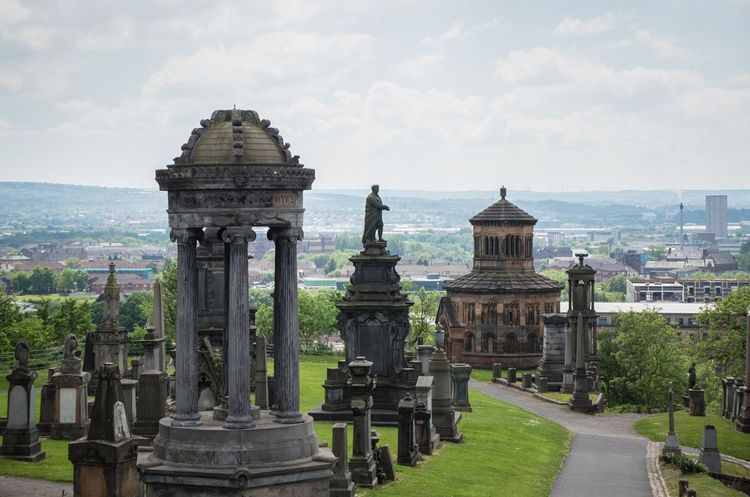
The Glasgow Necropolis, a cemetery in Glasgow, Scotland.
- © Kjetil Taksdal / ShutterstockWalk around the city
A great way to get better acquainted with Glasgow is to simply take the time to meander about. There are so many little nooks and crannies of the city that you can only really discover when you’ve decided to let the city take you where it wants you to go.
That said, there are various walks you can set your sights on and then get lost from there.
Strolling around Park Circus in the West End is a wonderful way to enjoy a more peaceful part of the city. The impressive concentric structure of the Victorian Park, designed in the 19th century by Glasgewian architect Charles Wilson, is delightful and makes for a great promenade spot in any season.
Pollok Country Park is the largest park in Glasgow and the only Country Park within the city limits. This incredible green space is part of the makeup of Old Pollok Estate, which also features the stunning Pollok House, a picture-perfect Edwardian home and the Burrell Collection which displays Sir William Burrell and his wife’s showstopping art collection which is free to visit.
The Clyde Walkway is a breathtaking route by the riverside, spanning around 65km between Glasgow all the way to New Lanark. If you don’t feel like committing to a major hike, you can take on a portion of it, and make it as long or short as you wish. We loved walking around 5km of the Walkway through the West End, this truly allows you to take in so many of Glasgow’s sites all at once. There are also many cute cafés and pastry shops along the way if you need to make a wee snack pit stop.
We really loved discovering Mudcock Country Park, located only 10 miles north of the city centre. It’s so rare to have access to such incredible displays of nature right outside big cities that it would be a shame not to take advantage of this one. The Park offers a hiking route, some preservation sites, a medieval castle and some incredible local wildlife. The grounds are open and accessible all day every day. The Park is free of entry with car parks open from 9am until 6.30pm.
A taste of the city
There are so many wonderful places to eat out in Glasgow, from established local favourites to newer up-and-coming joints, it’s hard to narrow down a list. That said, we’ve compiled some of our favourite picks here.
The Ubiquitous Chip is a staple of Scottish cuisine. Located on Ashton Lane, this restaurant has been serving the very best of Scottish food since the 1970s. You’ll get to experience their legendary hospitality and unparalleled Tasting Menus. Make sure you head to their Wee Whisky Bar after your meal to experience some of Scotland’s greatest offerings.
The Gannet, located in the Finnieston neighbourhood will take you on an entirely new and unique culinary adventure. Working with seasonal and locally sourced ingredients, this restaurant serves some of the finest meals in town. Their wine list is compact but excellent, serving some of the most excellent local wines.
88 Glasgow is located in Patrick and serves some of the most excellent Italian-inspired food in the city. Be sure to take their fresh homemade pasta dishes that change on a daily basis.
Fanny Trollopes specialises in seasonal Scottish food and dishes. Located on Argyle Street, this is the perfect rendez-vous spot for a fine dining experience and getting some of their signature seafood or lamb.
Glasgow is also full of adorable cafés if you're in want of a caffeine hit or some yummy sweet treats. In the West End, we love Papercup Coffee and the Alchemy Experiment. Sprigg in Merchant City is another one of our favourites.
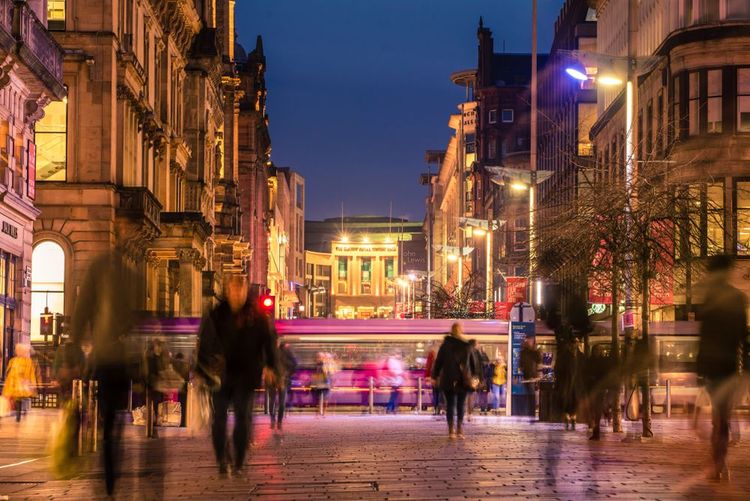
Pedestrians walking along the brightly lit Buchanan street in the city centre at night
- © Jennifer Sophie / ShutterstockPractical information about your visit
Bring an umbrella and a raincoat! No matter when you go, Scottish weather has a mind of its own and can change in the blink of an eye so make sure you are well prepared for it and are preemptively armed with rain gear.
We highly recommend spending at least two or three full days in Glasgow in order to get the most out of your visit.
Our favourite hotel in Glasgow
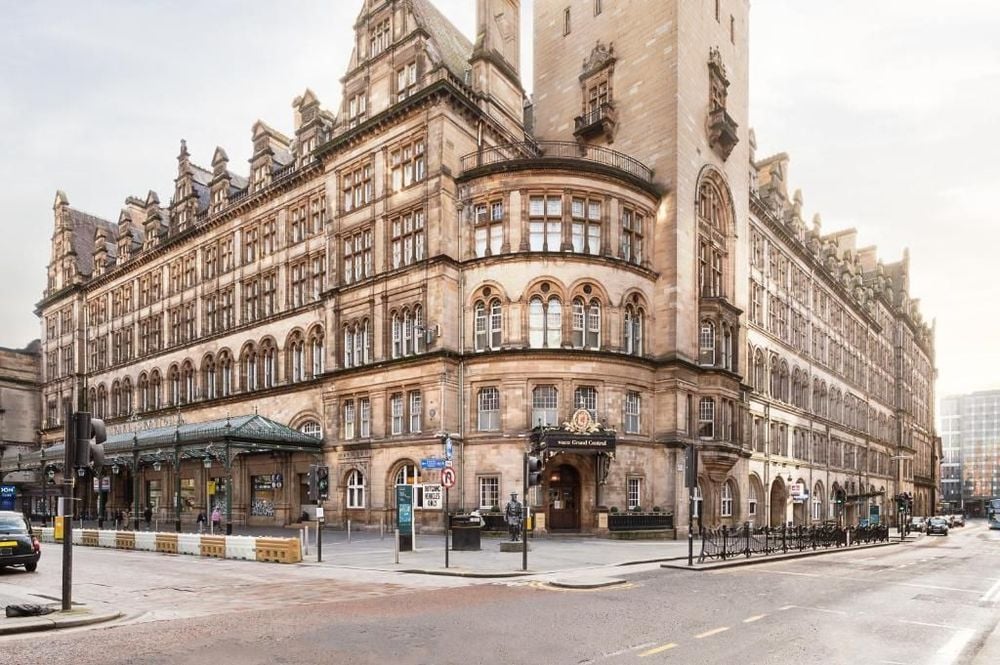 Scotland
Scotland
Voco Grand Central - Glasgow
A lovely hotel located in Glasgow's central shopping district, Scotland.How to get to Glasgow?
By car:
- Glasgow is linked to the following motorways: Edinburgh with the M8, England on the M74, Stirling with the M80 and the west coast of Scotland with the M77.
By plane:
- Glasgow Airport is very convenient due to its proximity to the city centre. An express bus shuttle service is available outside the terminal and takes you to the city centre in just 15 minutes.
By sea:
- You can reach Scotland by ferry from the major ports of Belfast and Larne in Northern Ireland. Ferries dock at Cairnryan in the southwest of Scotland, with a bus service taking passengers to Glasgow city centre in just a little over 2 hours.
- You can also travel from mainland Europe by sea. You can arrive in either: Hull where it's around a 4 hours drive to the Scottish border or Newcastle, which is around a 2 hours 40 minutes drive from Glasgow.
By train:
- Glasgow has two main train stations that connect the city to the rest of the UK: Glasgow Central Station links Glasgow to the south and Glasgow Queen Street Station operates routes mainly to Edinburgh and the north. Tickets can be purchased here.
Getting around Glasgow
Bicycles are a fantastic way of getting around Glasgow, with OVO bikes, hiring bikes and getting around the city is quick, efficient and easy.
The subway is one of the easiest ways of navigating the city centre, west end and southside of Glasgow. Running on average every 4 minutes at peak times, it takes only 24 minutes total to complete a circuit of the 15 stations. You can either buy a single ticket or, if you’re in town for a few days, it may be worth investing in a Subway Smartcard, which you can top up as you go.
That said, walking is still our favourite way of getting around Glasgow.
Some things to keep in mind for your visit
- Like everywhere else in Scotland, Summer is the best season to visit. That said, there’s something particularly charming about visiting Glasgow in the Autumn.
- Scotland does have its own banknotes but English pounds are accepted everywhere around the country although card and contactless payments are much more widespread.
- Citymapper is an excellent app to help you find your way around the city and get updates on any local public transport problems.
- A 12% service charge is typically already automatically added to bills when dining or eating out.
